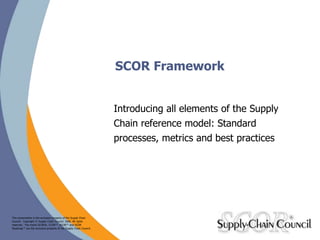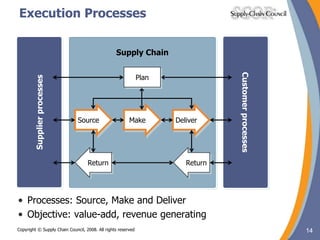This presentation provides an overview of the Supply Chain Council (SCC) and their Supply Chain Operations Reference (SCOR) framework. The SCC is a non-profit trade association focused on advancing supply chain management practices through the SCOR framework. SCOR provides standardized processes, metrics, and best practices for modeling supply chains across industries. It aims to help companies conduct business process reengineering, benchmarking, and identify best practices through its integrated approach. The presentation then demonstrates how to model a supply chain and characterize performance using the SCOR framework and its various levels and components.

























































![61
Metric: RL.1.1 Perfect Order Fulfillment
Definition: The percentage of orders delivered on-time, in full.
Components of perfect include all items and quantities on-
time, using the customer’s definition of on-time, complete
documentation and in the right condition
Calculation: [Total Perfect Orders] / [Total Number of Orders]
Diagnostic
Metrics:
(examples)
• RL.2.1 % Orders Delivered in Full
• RL.2.4 Perfect Condition
• RL.3.19 % Orders Received Defect Free
• RL.3.24 % Orders Received Damage Free
Notes: An order is perfect only if all L2/L3 metrics are perfect; An
order must be: on-time AND in-full AND right condition AND
right documentation
Copyright © Supply Chain Council, 2008. All rights reserved
Strategic Reliability Metric
61](https://image.slidesharecdn.com/scorframework2-201102063851/85/Scor-58-320.jpg)
![62
Metric: RS.1.1 Order Fulfillment Cycle Time
Definition: The average actual cycle time consistently achieved to fulfill
customer orders. The actual cycle time starts with the receipt
of the order and ends with the customer acceptance of the
delivery. The unit of measure is days.
Calculation: [Sum Actual Cycle Times For All Orders Delivered] / [Total
Number Of Orders Delivered]
Diagnostic
Metrics:
(examples)
• RS.2.2 Make Cycle Time
• RS.2.3 Deliver Cycle Time
• RS.3.96 Pick Product Cycle Time
Notes: Order Fulfillment Cycle Time includes dwell time. Dwell time is
the time no value add activities are performed on the order or
product, imposed by customer requirements.
Copyright © Supply Chain Council, 2008. All rights reserved
Strategic Responsiveness Metric
62](https://image.slidesharecdn.com/scorframework2-201102063851/85/Scor-59-320.jpg)

![64Copyright © Supply Chain Council, 2008. All rights reserved
Metric: AM.1.1 Cash-to-Cash Cycle Time
Definition: The time it takes for cash invested in materials to flow back
into the company after finished goods have been delivered to
customers. The unit of measure for Cash-to-Cash Cycle Time
is calendar days
Calculation: [Inventory Days of Supply] + [Days Sales Outstanding] –
[Days Payable Outstanding]
Diagnostic
Metrics:
• AM.2.1 Days Sales Outstanding (DSO)
• AM.2.2 Inventory Days of Supply (IDOS)
• AM.2.3 Days Payable Outstanding (DPO)
Notes: For services, the time between paying the resources assigned
to a service and receiving payment for the service delivery.
Strategic Asset Metrics
64](https://image.slidesharecdn.com/scorframework2-201102063851/85/Scor-61-320.jpg)
![65Copyright © Supply Chain Council, 2008. All rights reserved
Metric: AM.1.2 Return on Supply Chain Fixed Assets
Definition: The return an organization receives on its invested capital in
supply chain fixed assets. This includes the fixed assets used
to Plan, Source, Make, Deliver and Return. Examples of fixed
assets include land, buildings, machinery, trucks
Calculation: ([Supply Chain Revenue] – [COGS] – [Supply Chain
Management Costs]) / [Supply Chain Fixed Assets]
Diagnostic
Metrics:
• AM.3.11 Deliver Fixed Assets Value
• AM.3.18 Make Fixed Assets Value
• AM.3.20 Plan Fixed Asset Value
• AM.3.27 Source Fixed Assets Value
Notes: Supply-Chain Revenue is the operating revenue generated
from a supply chain. This does not include non-operating
revenue, such as investments, etc..
Strategic Asset Metrics
65](https://image.slidesharecdn.com/scorframework2-201102063851/85/Scor-62-320.jpg)









